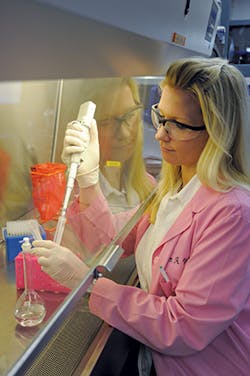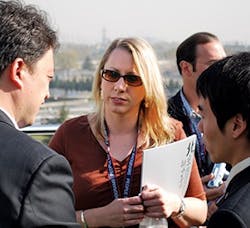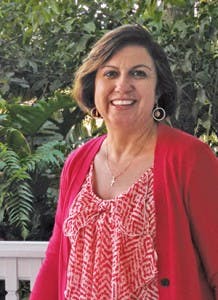We profile one reader in every issue of Water Efficiency, and maybe you are accustomed to going directly to the back page to see who is there and what they are doing. This issue, as in every issue, we have an inspiring reader profiled right where you are used to seeing it: Florida conservation advocate Judith Benson.
Meanwhile, we thought these three additional profiles could be shared together for a separate feature, because each one offers a glimpse into an area of water resource management that is demanding greater attention in these precarious times. And all are views of women pushing these science, technology, engineering, and mathematics (STEM) fields forward, topical since keeping girls engaged in STEM education keeps appearing in the news.
The silos of water systems are breaking down and the concept of water being “all one” is coming to the global consciousness. Seawater, stormwater, wastewater, reclaimed, and reuse water—more and more these cannot be ignored by those working in potable water systems, nor by those concerned with the other features and functions of the civilized landscape. As more people on the planet share resources, the big picture of interconnectedness gets clearer.
Each of these three women has distinguished herself within one of these dynamic areas, and we raise our water glasses to toast them. We also invite you to share these profiles with young people in your midst. Those who choose careers in water are doing important work; the flow of the future will be in their hands. In light of the need to pass the torches, we will also present a feature on internships in the water sector in a future issue.
Lauren Weinrich
Lauren Weinrich describes one of her greatest moments as the day her doctoral advisor shook her hand, calling her “doctor” after she successfully defended her dissertation.
Working on a Ph.D., and as a full-time senior research analyst in American Water’s Innovation & Environmental Stewardship Department was challenging, but her ability to do so does not surprise those who know Weinrich, who is considered a rising industry superstar. She recently received the Leadership Development Award from the American Chemical Society’s (ACS) Younger Chemist Committee for her “tremendous potential to be a successful leader within her profession and within the ACS.”
Her department’s director, Mark LeChevallier, says with just 10 years working in the industry, Weinrich has become “an exceptional scholar; she has a passion for learning and research and demonstrates strong potential for success in the water industry.”
Cognizant of desalination being a solution upon which coastal areas will increasingly rely, but noting the challenge of cost associated with seawater desalination and reverse osmosis, Weinrich points out that her curiosity over whether that “extremely expensive effect” could be controlled led to her dissertation on biological fouling of reverse osmosis membranes. While working at American Water, she examined the role of assimilable organic carbon (AOC), a fraction of organic carbon readily biodegraded.
“We developed the Bioluminescence AOC Method here years ago; it is used by a commercial laboratory in drinking and reclaimed water projects,” she says. “It’s like candy to bacteria. They will go for this fraction of organic carbon before they go for anything else. It’s a huge concern in the distribution system.”
Using funding from the Water Reuse Research Foundation and conducting research at the Tampa Bay (FL) Seawater Desalination Plant, “I developed a seawater AOC test that I applied, and found treatment will in some cases increase AOC in the reverse osmosis feed water and therefore, this fouling issue would occur,” says Weinrich. “If we can monitor this certain fraction using the test I helped develop, we can get a better handle on biological stability and safety in the water.”
What She Does Day to Day
A typical day might encompass a Bench-Scale Analysis of organic carbon, doing report writing, data analysis, or statistical analysis. In addition to monitoring biological fouling on reverse osmosis membranes, particularly for seawater desalination, Weinrich works on grant-funded research projects as well as provides support for American Water’s various US operations. She also mentors high school science students.
What Led Her Into This Line of Work
Growing up in Pennsylvania on four acres that included a stream, Weinrich enjoyed spending time outdoors. She earned a B.S. in biology from Marymount University, graduating cum laude, and an M.S. in environmental sciences from North Carolina–Chapel Hill, where she did lab work using analytical chemistry to evaluate how new treatment processes such as ozone affected drinking water disinfection byproducts. Weinrich returned to Pennsylvania, where she got a job with American Water 10 years ago and also began her Ph.D. work in environmental engineering at Drexel University.
What She Likes Best About Her Work
“It means a lot to do something that you have a knack for,” says Weinrich. “Everyone needs clean drinking water. It’s our life source. We’re lucky in this country to turn on any tap and have safe water coming out and I’m a part of that.” She also enjoys looking for solutions that will, going forward, ensure safe drinking water in a changing climate and its effect on certain areas. “It’s great to be with a company that shares my same goals: to help solve problems, make sure these new technologies are producing safe water, and continue to use our resources appropriately,” she says.
Her Greatest Challenge
With the obstacle of combining work with Ph.D. studies behind her, Weinrich focuses her attention on using the scientific method to address ongoing industry challenges, such as improving biological filtration to remove certain components from water so the downstream processes and distribution water is safe. Other challenges: figuring out the chemistry of certain emerging contaminants and how to remove them from the treatment plant. “It’s collecting enough data to be sure that no matter what we’re looking at, we have the right evidence to make informed decisions,” says Weinrich.
Cerda is a senior project manager with Burgess & Niple Inc., a multidiscipline engineering and architectural firm in Austin, TX. Cerda’s work has taken her as far as China, where she served as a delegate for Water for People to speak with Chinese officials at a Beijing wastewater treatment plant. She chairs the Water Environment Association of Texas Collection Systems Committee and was the 2009 recipient of the Sidney L. Allison Award for contributions to the engineering, operation, and maintenance of wastewater collection and transportation. She’s also a 2014 inductee into the Select Society of Sanitary Sludge Shovelers.
What She Does Day to Day
Cerda’s daily duties include managing and performing engineering tasks in water and wastewater system projects. “My specialties include system assessment and rehabilitation systems,” she says. “My work day can consist of reviewing data collected in the field on access structure and pipe condition, performing data analysis on wastewater flow and rainfall monitoring data, conducting site visits and evaluations, and developing/implementing recommendations for remedying system problems.” Her professional focus is monitoring system flows, which includes first evaluating the feasibility of flow monitoring and discerning the technology that should be applied. She does a great deal of work with commercially available flow measurement technologies in open channel (closed-conduit) applications, lift station monitoring, and designing flume structures.
Cerda’s passion is infrastructure rehabilitation. “It allows me to apply my knowledge of condition system assessment with my experience in rehabilitation methodologies such as pipe and manhole liners and coatings,” says Cerda. “I work to combine all of my knowledge and experience as I attempt to help others in achieving their system maintenance and management goals and keeping the regulatory authorities at bay.”
What Led Her to This Line of Work
While a student at the University of Texas at Austin, Cerda took on an internship with the City of Austin Water Utility during her winter break of January 2003 at the urging of a high school friend. Her original education goal was chemical/environmental engineering. The internship introduced her to water and wastewater systems. She was intrigued by the wastewater side, which allowed her to combine her love of math (data analysis application applied in flow monitoring) and chemistry (polymer materials applied in rehabilitation applications). “Field work opened my eyes and mind to the reality that things are not always as they theoretically should be,” says Cerda. That experience led her to pursue civil and wastewater engineering courses in her junior and senior years. After completing her education, Cerda worked for the Austin Water Utility for 10 years in various capacities. She moved into private consulting more than 11 years ago.
What She Likes Best About Her Work
“Water and wastewater is a truly dynamic industry,” says Cerda. “Whether it is new methods or materials for infrastructure or changing regulatory compliance, it is constantly changing. Stewardship to the industry is my daily drive. I feel I am working to make every water or wastewater system I have the opportunity to work in a little bit more efficient and effective. My hope is that my work will have some impact on the industry and the environment for the next generation, leaving it a little better than I found it.”
Her Greatest Challenge
“Balancing my passion for my work with what is feasible in terms of time and project budget is always a challenge,” says Cerda. “Could I evaluate infrastructure a little more to ensure I have made the most cost-effective recommendation I can? Have I missed anything in my data analysis and review such that my conclusions and recommendations are as accurate as the data allows? Working in the water and wastewater industry brings to light that everything you do could impact the environment, aquatic life and—most importantly—human health. That reality makes my work both a challenge and reward.”
The utility has reached its second tier of process improvements. Those efforts have earned an extensive list of awards from local honors to federal recognition by EPA for effective and sustainable water management. The utilities department participates in benchmarking information for water, wastewater, and stormwater with the Florida Benchmarking Consortium, a group of cities and counties, as well as with the Southeast Florida Utility Council.
“Other utilities ask us about our reuse program because it is so different,” says Loucraft. “They also ask about our efficiency and process improvement program. If we’re interested in a new technology, we won’t just call the vendor—we will go to another utility to see it in action before we consider implementation. We encourage others to come here and do the same. That constant back and forth sharing helps make it better.”
What She Does Day to Day
Loucraft’s general plan for each day may be interrupted by a water main break, a customer inquiry about reuse water, or emergency preparations for a weather event such as a hurricane. For the most part, she works with water supply numbers, reuse connection plans as part of the city’s conservation strategy, and future projections for water conservation. She does benchmarking to track how well the utilities department is faring in the city’s strategic plan. Loucraft also uses the Lean Six Sigma process as a blueprint for improving current operations. “We not only have to worry about being efficient on the outside—using the most efficient technologies or making sure that our water supply is used the most efficiently—but we also have to be efficient in our operations,” she notes. Loucraft facilitates the work of in-house teams measuring process improvement performance.
What Led Her to This Line of Work
During college, Loucraft was on a pre-med path that started at Mercer University in Macon, GA, and went on to the University of South Florida, where she earned a B.S. degree in chemistry. She instead took employment in the South Florida Water Management District (SFWMD) laboratory, then worked for a utility plant lab. She then did quality assurance work for SFWMD before taking a job with Pompano Beach’s utility laboratory. Through her experiences, Loucraft learned many utilities weren’t fully addressing conservation programs, outreach, safety, and grants. She turned her focus to those factors, working to make the processes better and more efficient and leading to the creation of her job as compliance and efficiency manager.
What She Likes Best About Her Work
“The greatest satisfaction is seeing change and seeing processes get improved,” says Loucraft. “The best part of this is I work in an invisible area where you can create a system or process out of nothing and after you put in all of the pieces, you’ve got something that’s a good service or a process that has value.”



